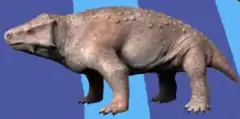Parasaurus
Parasaurus (meaning "near lizard") is a dubious genus of pareiasaur known from fossils collected in the Kupferschiefer in Germany (Hesse, Thuringia and Lower Saxony). The type species, Parasaurus geinitzi, described by Hermann von Meyer in 1857, was the first pareiasaur ever described. The seven known specimens were redescribed in 2008.[1]
| Parasaurus | |
|---|---|
 | |
| Restoration | |
| Scientific classification | |
| Kingdom: | Animalia |
| Phylum: | Chordata |
| Class: | Reptilia |
| Clade: | †Parareptilia |
| Order: | †Procolophonomorpha |
| Clade: | †Pareiasauria |
| Family: | †Pareiasauridae |
| Genus: | †Parasaurus von Meyer, 1857 |
| Type species | |
| †Parasaurus geinitzi von Meyer, 1857 | |
Discovery and naming
As early as 1848, pareiasaur fossils have been reported from Germany - some of these fossils may have belonged to Parasaurus.[2] It was not until 1857 when von Meyer described these fossils and created the Parasaurus genus.[3] von Meyer classified Parasaurus as a reptile but it was classified as a pareiasaur when the family was created in 1888.[4][5] Lee (1997) classified Parasaurus as a nomen dubium. In 2008, Tsuji and Müller re-evaluated the genus.[1]
Phylogeny
Below is a cladogram from Tsuji et al. (2013):[6]
| Pareiasauria |
| ||||||||||||||||||||||||||||||||||||||||||||||||||||||||||||||||||||||||||||||||||||||||||||||||||||||
References
- L. A. Tsuji and J. Müller. 2008. A Re-evaluation of Parasaurus geinitzi, the first named pareiasaur (Amniota, Parareptilia). Canadian Journal of Earth Sciences 45(10):1111-1121
- Geinitz, H.B. 1848. Die Versteinerungen des deutschen Zechsteingebirges. In Die Verteinerungen des Zechsteingebirges und Rothliegenden oder des permischen Systemes in Sachsen. Edited by H.B. Geinitz and A. von Gutbier. Arnoldische Buchhandlung, Dresden and Leipzig, pp. 1–29. Google Scholar
- von Meyer, 1857
- H. G. Seeley. 1888. Croonian Lecture: Researches on the Structure, Organization, and Classification of the Fossil Reptilia. II. On Pareiasaurus bombidens (Owen), and the Significance of Its Affinities to Amphibians, Reptiles, and Mammals. Philosophical Transactions of the Royal Society of London B 179:59-109
- Society of Vertebrate Paleontology (24 June 2013). "Pareiasaur: Bumpy beast was a desert dweller". ScienceDaily. Retrieved 17 May 2014.
- Tsuji, L. A.; Sidor, C. A.; Steyer, J. - S. B.; Smith, R. M. H.; Tabor, N. J.; Ide, O. (2013). "The vertebrate fauna of the Upper Permian of Niger—VII. Cranial anatomy and relationships of Bunostegos akokanensis (Pareiasauria)". Journal of Vertebrate Paleontology. 33 (4): 747–763. doi:10.1080/02724634.2013.739537. S2CID 86097405.